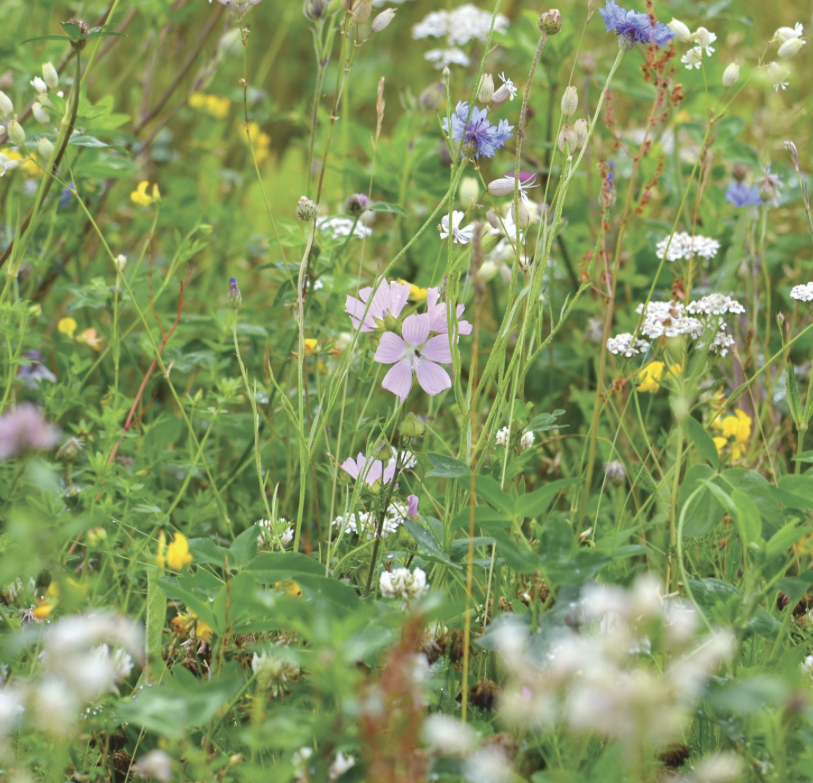Wild Flower Turf – Brids and Bees mix
We’ve put together a mix of 41 native British wildflowers that will encourage a wide variety of wildlife into your garden.
Besides being a joy to share your space with, Garden Birds and Bees Meadowmat has many features to actively support biodiversity.
- A long flowering period. Which means that it supplies pollen and nectar for bees, butterflies, hoverflies and moths all through the spring and summer months and well into autumn too.
- Source of food for caterpillars and therefore a vital part of butterfly and moth life cycles.
- Autumn seed heads and a ready supply of insects and larvae for birds.
- For the human visitors to your garden there are colourful flowers and the fascination of watching wild creatures going about their everyday life.
Please call 01872 870904 to place your order
Key Points
- Garden Birds and Bees Meadowmat contains mostly perennial plant species. Install it once and the plants will grow back year after year (provided the conditions are right).
- Not all of the flowering species are perennial. We’ve included some annual and bi-annuals too. These may not appear every year.
- Flowering Time: March– September (depending on local weather conditions).
- Meadowmat will not be in flower when it is delivered to you. We trim the plants before despatch to protect them from damage in transit.
- Meadowmat can be installed at any time of year. However, to be certain of seeing flowers in its first summer, install Garden Birds and Bees Meadowmat before the end of march.
- Each roll of Garden Birds and Bees Meadowmat covers 1 square metre of prepared soil and can be quite heavy. We recommend having two people to install it.
- Your Meadowmat will change appearance from year to year because the balance of plant species is affected by weather, soil type and management.
What is Meadowmat?
Meadowmat, it’s an ingenious outdoor landscaping material that helps you to grow a mature wildflower meadow in the least time possible. It’s far more reliable than sowing seed and quicker and easier than plugplanting. Think of Meadowmat as a flower garden on a roll. Lay Meadowmat in a similar way to lawn turf, but maintain it like a wildflower meadow.
It’s easy to look after Garden Birds and Bees Meadowmat. Once it has established it can be left to grow unchecked all through spring, summer and autumn. There’s no need for mowing, feeding, deadheading or pest control. Mother Nature will take care of everything for you. Towards the end of winter, (usually late February) or when all of the seed heads have been eaten by birds. Cut your Garden Birds and Bees Meadowmat back to a height of 10 – 15 cm and take away all of the clippings. Sometimes, during a wet mild summer, you may find that some of the plants fall over – if this happens, simply trim them back to tidy them.
Growing Garden Birds and Bees Meadowmat – Soil and Aspect
Garden Birds and Bees Meadowmat prefers to grow in full sun and moist, but well drained low fertility soil. It is happy on level surfaces or slopes. Happiest in a fairly neutral pH but will tolerate all but the most acidic or alkaline soils.
Ordinary garden soil is usually high in the plant nutrients that grasses love. It is quite likely that after a few months the grasses will become so strong that they outcompete many of the flowering plants. The result will be a beautifully grassy meadow but with less colour than you perhaps hoped for.
What’s In Garden Birds and Bees Meadowmat?
Please note, percentages refer to the weight of the seed in the growing mix and do not necessarily reflect the proportions of mature plants.
100% native wildflowers
For a colourful display that provides lots of pollen and nectar to support beneficial insects all the way from early spring to late autumn.
- Agrimony
- Autumn hawkbit
- Birdsfoot trefoil
- Bladder Campion
- Chicory
- Clustered bellflower
- Columbine
- Common mallow
- Common sorrel
- Common toadflax
- Cornflower
- Daisy
- Fennel
- Field poppy
- Fox and Cubs
- Foxglove
- Grandmothers Garden
- Greater Knapweed
- Harebell
- Maiden pink
- Meadow buttercup
- Meadow cranes-bill
- Musk mallow
- Purple loosestrife
- Ragged robin
- Red campion
- Red clover
- Sheeps bit
- Small scabious
- Tansy
- Teasel
- Viper’s bugloss
- White campion
- White clover
- Wild Basil
- Wild carrot
- Wild clary
- Wild marjoram
- Wild pansy
- Wild thyme
- Yarrow

